Investigations into the Surface Strain/Stress State in a Single-Crystal Superalloy via XRD Characterization
Abstract
:1. Introduction
2. Experimental Procedure
2.1. Material and Heat Treatment
2.2. Determination Process of the Surface Strain/Stress State
3. Results
3.1. Microstructure Observation
3.2. Lattice Parameter and Mismatch
3.3. Surface Strain/Stress State
3.3.1. for γ/γ′ Phases
3.3.2. Von Mises Stress of γ/γ′ Phases
4. Discussion
5. Conclusions
Author Contributions
Funding
Acknowledgments
Conflicts of Interest
Appendix A
References
- Reed, R.C. The Superalloys: Fundamentals and Applications; Cambridge University Press: Cambridge, UK, 2006. [Google Scholar]
- Du, W.; Li, J. Solidification and microsegregation behaviors of Nickel-based single crystal superalloy solidified at medium cooling rate. Trans. Nonferr. Met. Soc. China 1998, 8, 84–88. [Google Scholar] [CrossRef]
- Dong, T.; Gao, C. Effect of substrate orientations on microstructure evolution and stability for single crystal superalloys in rapid solidification process. Mater. Des. 2017, 128, 218–230. [Google Scholar] [CrossRef]
- Han, J.C.; Dutta, S. Gas Turbine Heat Transfer and Cooling Technology. EPFL 2001, 9, 82. [Google Scholar] [CrossRef]
- Bunker, R.S. A Review of Shaped Hole Turbine Film-Cooling Technology. J. Heat Transf. 2005, 127, 441–453. [Google Scholar] [CrossRef]
- Kim, T.W.; Kang, D.H.; Yeom, J.T. Continuum damage mechanics-based creep–fatigue-interacted life prediction of nickel-based superalloy at high temperature. Scr. Mater. 2007, 57, 1149–1152. [Google Scholar] [CrossRef]
- Huang, Z.W.; Wang, Z.G.; Zhu, S.J. Thermomechanical fatigue behavior and life prediction of a cast nickel-based superalloy. Mater. Sci. Eng. A 2006, 432, 308–316. [Google Scholar] [CrossRef]
- Burgel, R.; Portella, P.D.; Preuhs, J. Recrystallization in Single Crystals of Nickel Base Superalloys. Superalloys 2000, 5, 229–238. [Google Scholar] [CrossRef]
- Huang, Q.; Ren, J.X. Surface integrity and its effects on the fatigue life of the nickel-based superalloy GH33A. Int. J. Fatigue 1991, 13, 322–326. [Google Scholar] [CrossRef]
- Dalaei, K.; Karlsson, B. Stability of shot peening induced residual stresses and their influence on fatigue lifetime. Mater. Sci. Eng. A 2011, 528, 1008–1015. [Google Scholar] [CrossRef]
- Pandya, S.G.; Corbett, J.P. Structural characterization and X-ray analysis by Williamson–Hall method for Erbium doped Aluminum Nitride nanoparticles, synthesized using inert gas condensation technique. Physica E 2016, 79, 98–102. [Google Scholar] [CrossRef]
- Aly, K.A.; Khalil, N.M. Estimation of lattice strain for zirconia nano-particles based on Williamson–Hall analysis. Mater. Chem. Phys. 2017, 193, 182–188. [Google Scholar] [CrossRef]
- Kurlyandskaya, G.V.; Lukshina, V.A. Induced magnetic anisotropy features in FeCrSiBNbCu nanocrystalline alloy: Role of stress distribution proven by direct X-ray measurements. J. Alloys Compd. 2013, 566, 31–36. [Google Scholar] [CrossRef]
- Ortner, B. Simultaneous determination of the lattice constant and elastic strain in cubic single crystal. Adv. X-ray Anal. 1985, 29, 113–118. [Google Scholar]
- Wu, E.; Sun, G. Neutron Diffraction Study of Strain/Stress States and Subgrain Defects in a Creep-Deformed, Single-Crystal Superalloy. Metall. Mater. Trans. A 2013, 45, 139–146. [Google Scholar] [CrossRef]
- Wu, E.; Li, J. Neutron and X-ray Diffraction Study of Internal Stress in Thermomechanically Fatigued Single-Crystal Superalloy. Metall. Mater. Trans. A. 2008, 39, 3141–3148. [Google Scholar] [CrossRef]
- Morançais, A.; Fèvre, M. Residual stress determination in a shot-peened nickel-based single-crystal superalloy using X-ray diffraction. J. Appl. Crystallogr. 2015, 48, 1761–1776. [Google Scholar] [CrossRef]
- Marty, B.; Moretto, P. X-ray study on single crystal superalloy SRR99: Mismatch γ/γ′, mosaicity and internal stress. Acta Mater. 1997, 45, 791–800. [Google Scholar] [CrossRef]
- Morançais, A.; Morançais, A. Influence of Residual Stresses on the Fatigue Life of a Shot-Peened Nickel-Based Single Crystal Superalloy: From Measurements to Modeling. In Superalloys 2016, Proceedings of the 13th Intenational Symposium of Superalloys, Seven Springs, PA, USA, 11–15 September 2016; John Wiley & Sons, Inc.: Hoboken, NJ, USA, 2016. [Google Scholar]
- Wu, E.; Sun, G. A neutron diffraction study of lattice distortion, mismatch and misorientation in a single-crystal superalloy after different heat treatments. Acta Mater. 2013, 61, 2308–2319. [Google Scholar] [CrossRef]
- Volek, A.; Pyczak, F. Partitioning of Re between γ and γ′ phase in nickel-base superalloys. Scr. Mater. 2005, 52, 141–145. [Google Scholar] [CrossRef]
- Ma, S.Y.; Ren, N.N.; Zhang, J.X. Observation of morphology and stress distribution around dislocation in Ni3Al on the atomic scale. Solid State Commun. 2015, 211, 4–9. [Google Scholar] [CrossRef]
- Huang, W.-J.; Ji, V. Strain and stress analysis on Zn multicrystal film by XRD method. Trans. Nonferr. Met. Soc. China 2006, 16, s735–s738. [Google Scholar] [CrossRef]
- M’Cirdi, L. Experimental approach of a crystallographic cleavage criterion in a cast aged duplex stainless steel. Acta Mater. 2001, 49, 3879–3887. [Google Scholar] [CrossRef]
- François, M.; Ferreira, C.; Guillén, R. Approximate Analytical Formulae to Evaluate the Uncertainty in X-ray Stress Analysis. Mater. Sci. Forum 2005, 490–491, 124. [Google Scholar] [CrossRef]
- Kuhn, H.A.; Biermann, H. An X-ray study of creep-deformation induced changes of the lattice mismatch in the γ′-hardened monocrystalline nickel-base superalloy SRR 99. Acta Metall. Mater. 1991, 39, 2783–2794. [Google Scholar] [CrossRef]
- Dirand, L.; Cormier, J. Measurement of the effective γ/γ′ lattice mismatch during high temperature creep of Ni-based single crystal superalloy. Mater. Charact. 2013, 77, 32–46. [Google Scholar] [CrossRef]
- Mohamed, I.F.; Yonenaga, Y. Age hardening and thermal stability of Al–Cu alloy processed by high-pressure torsion. Mater. Sci. Eng. A 2015, 627, 111–118. [Google Scholar] [CrossRef]
- Kang, Z.; Yanzhong, L. Experimental study on cool down characteristics and thermal stress of cryogenic tank during LN2 filling process. Appl. Therm. Eng. 2018, 130, 951–961. [Google Scholar] [CrossRef]
- Wilson, B.C.; Hickman, J.A.; Fuchs, G.E. The effect of solution heat treatment on a single-crystal Ni-based superalloy. JOM 2003, 55, 35–40. [Google Scholar] [CrossRef]
- Ma, S.; Lv, X. Core structure and strengthening mechanism of the misfit dislocation in nickel-based superalloys during high-temperature and low-stress creep. J. Alloys Compd. 2018, 743, 372–376. [Google Scholar] [CrossRef]
- Ru, Y.; Zhang, H. Improved 1200 °C stress rupture property of single crystal superalloys by γ′-forming elements addition. Scr. Mater. 2018, 147, 21–26. [Google Scholar] [CrossRef]
- Grosdidier, T.; Hazotte, A.; Simon, A. Precipitation and dissolution processes in γ/γ ′ single crystal nickel-based superalloys. Mater. Sci. Eng. A 1998, 256, 183–196. [Google Scholar] [CrossRef]
- Biermann, H.; Strehler, M.; Mughrabi, H. High-temperature measurements of lattice parameters and internal stresses of a creep-deformed monocrystalline nickel-base superalloy. Metall. Mater. Trans. A 1996, 27, 1003–1014. [Google Scholar] [CrossRef]
- Siebörger, D.; Knake, H.; Glatzel, U. Temperature dependence of the elastic moduli of the nickel-base superalloy CMSX-4 and its isolated phases. Mater. Sci. Eng. A 2001, 298, 26–33. [Google Scholar] [CrossRef]
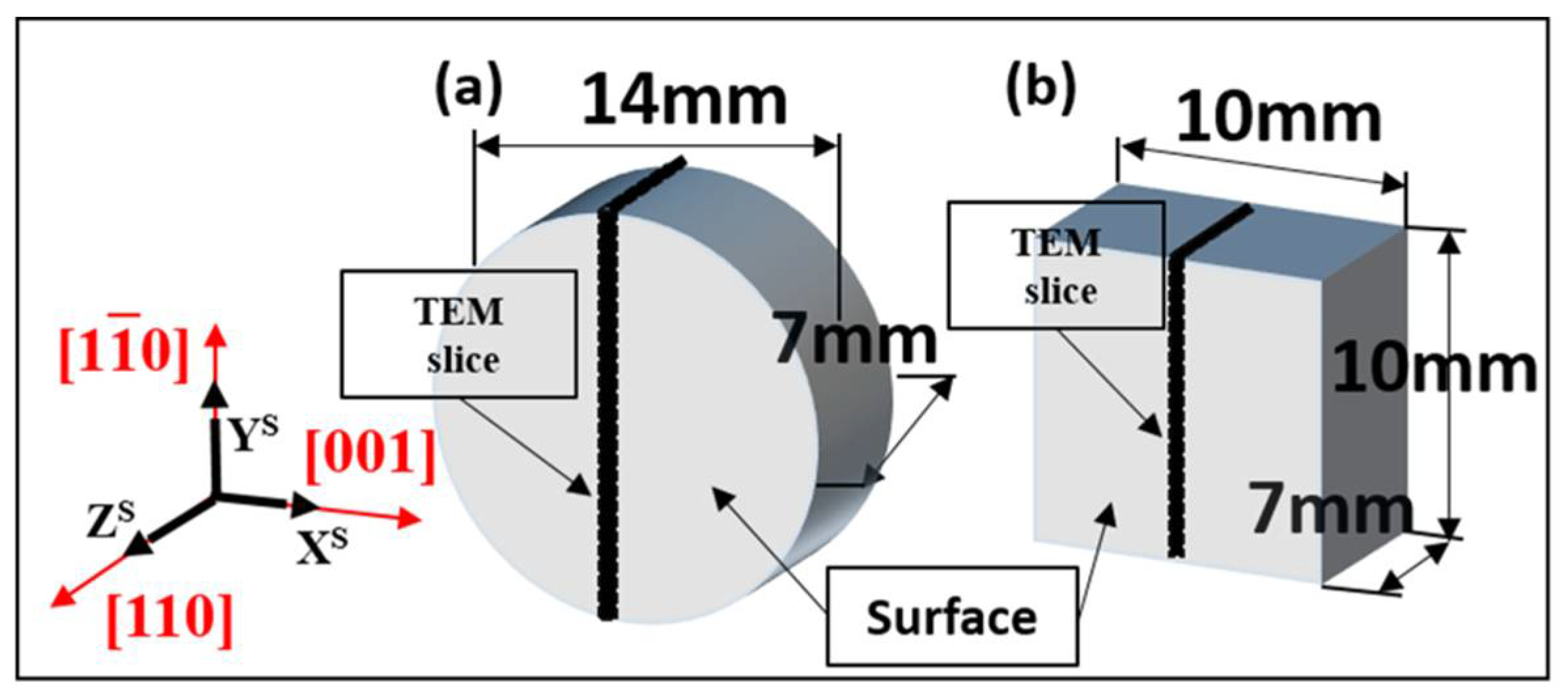
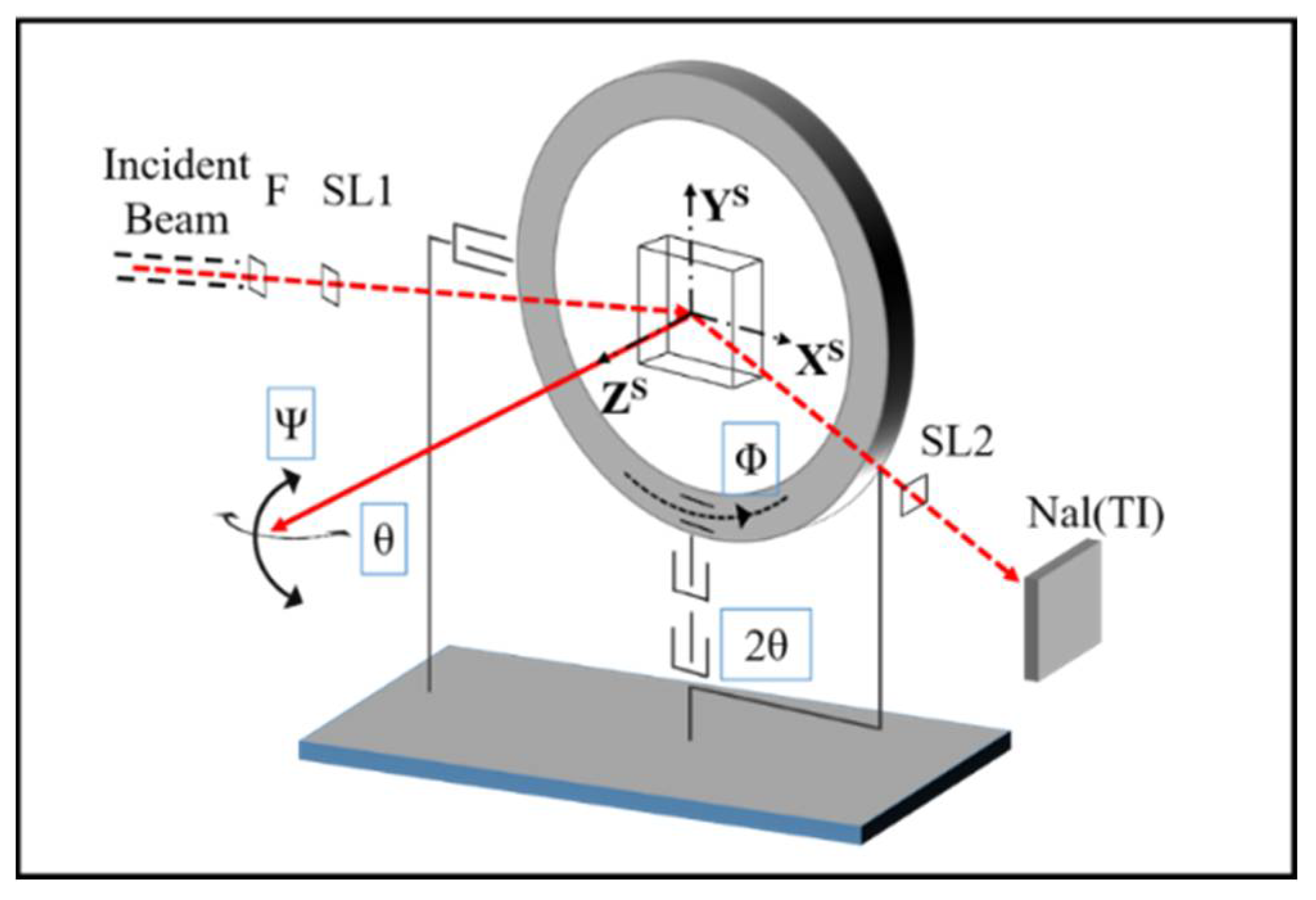
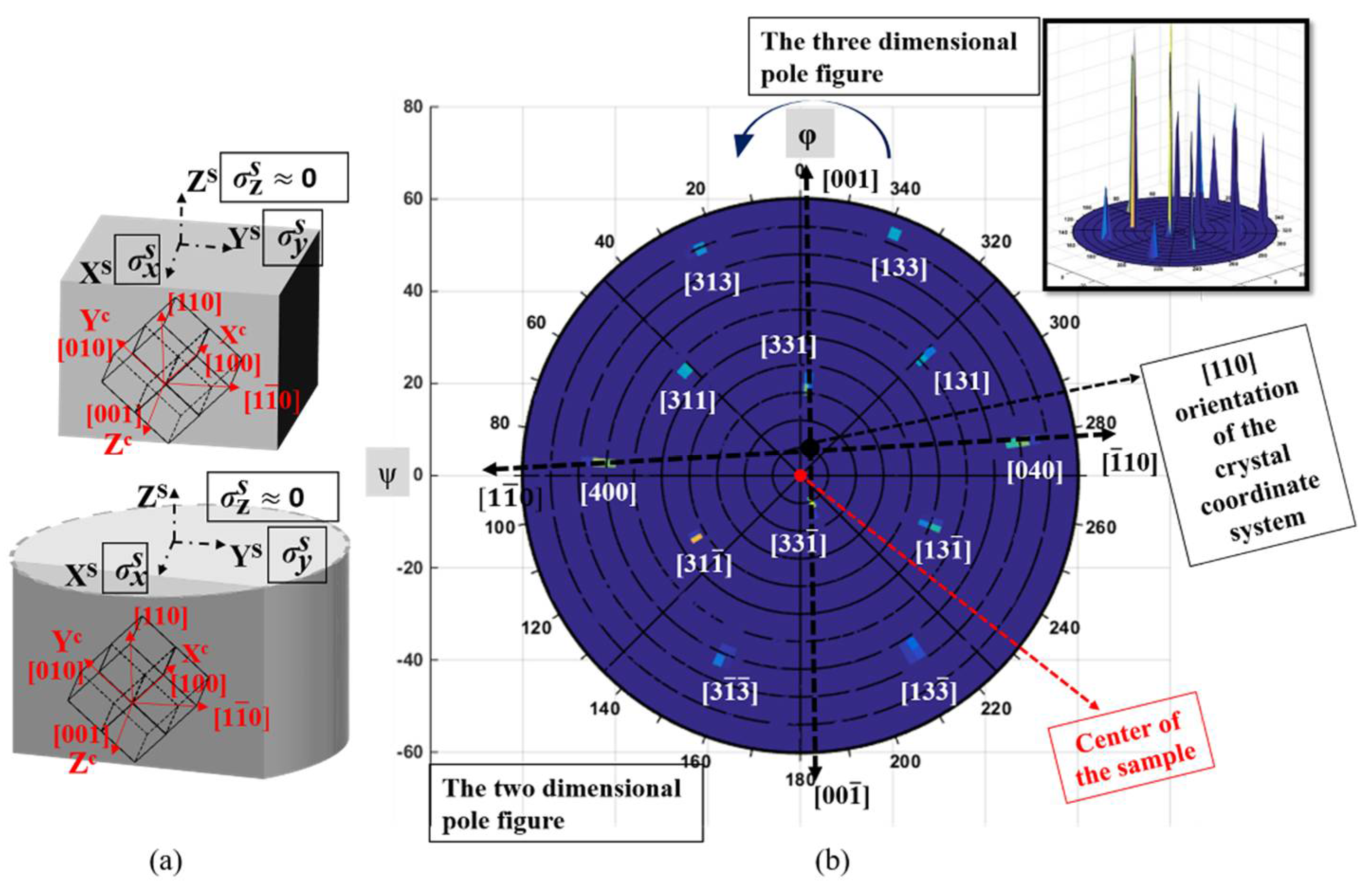


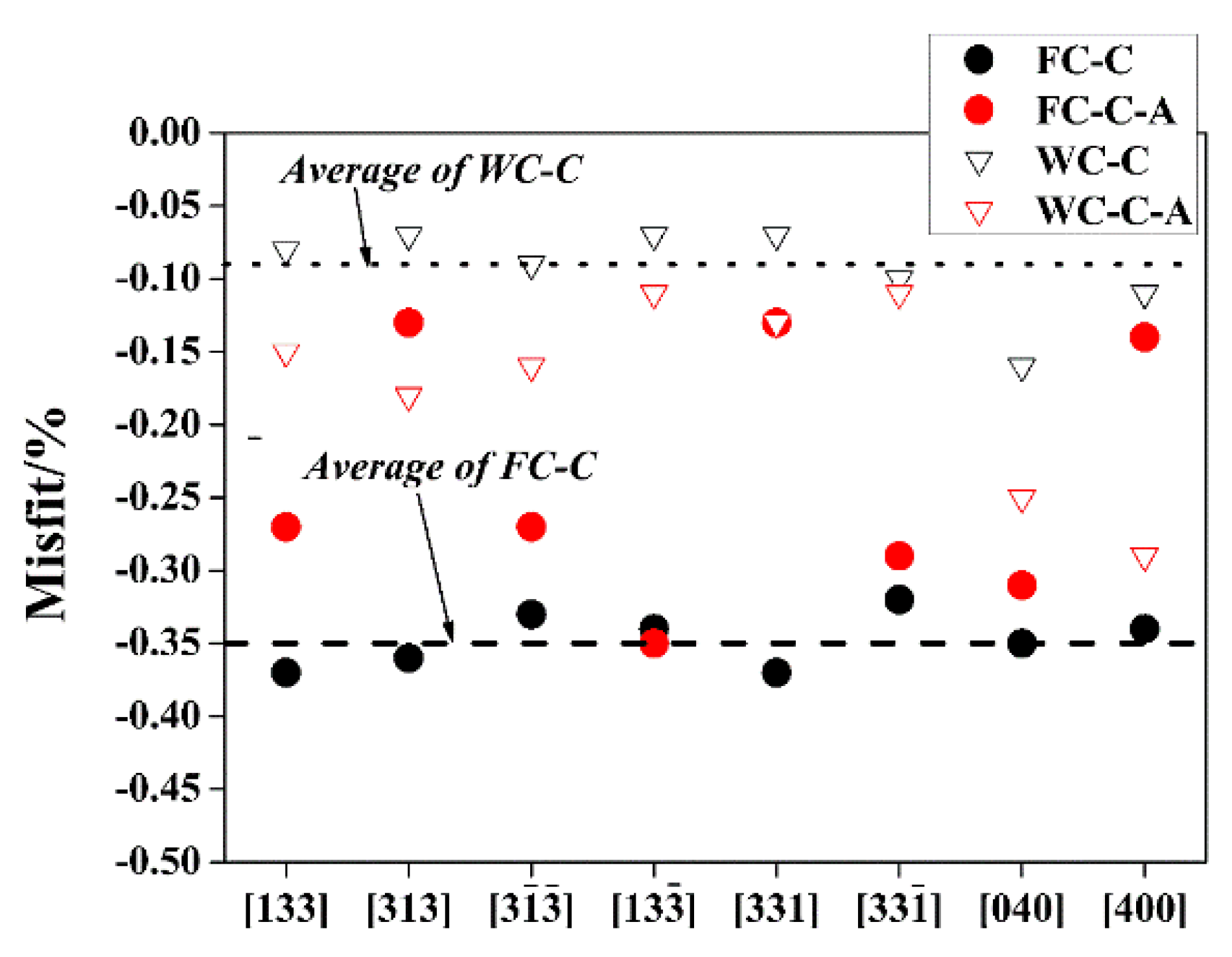
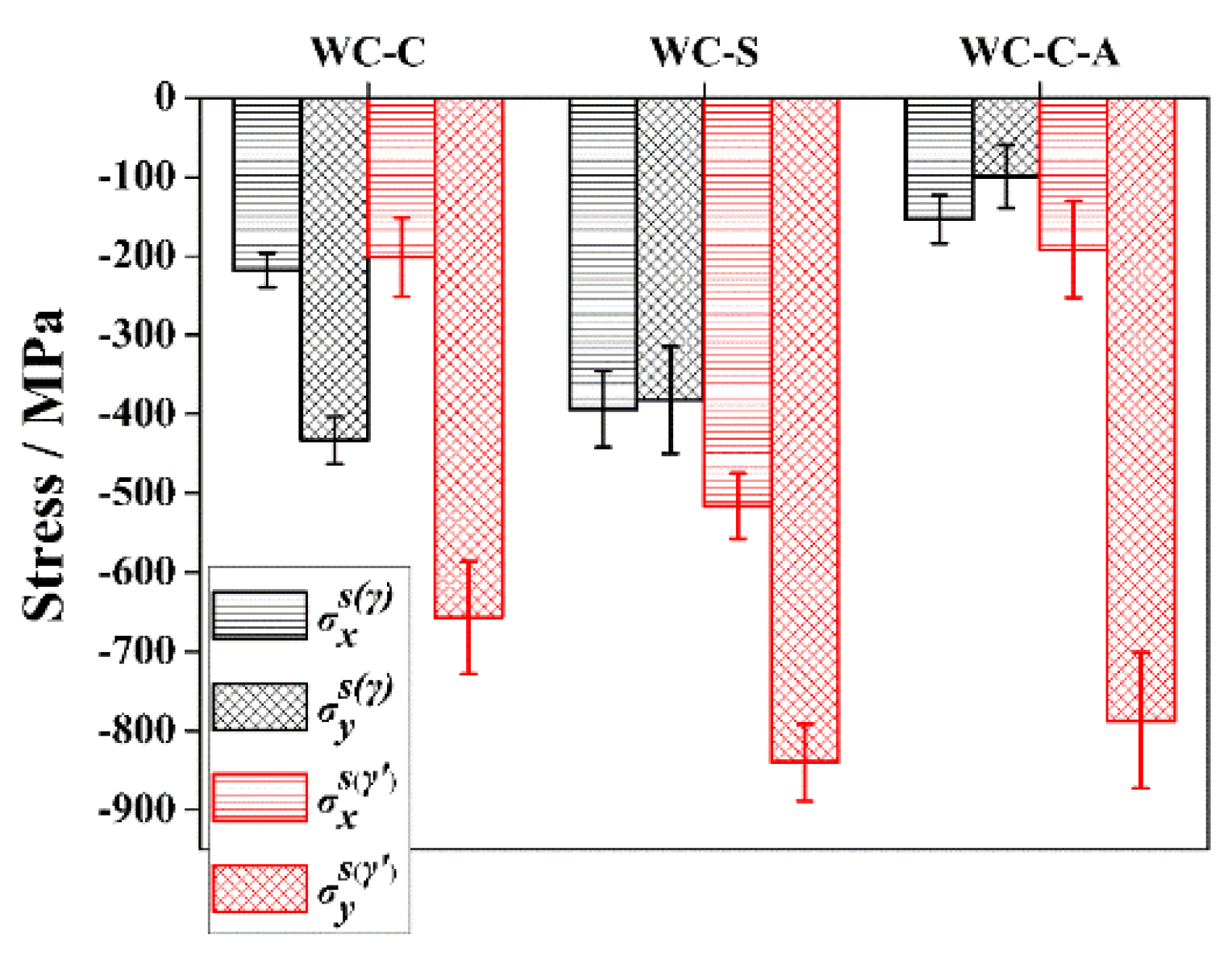
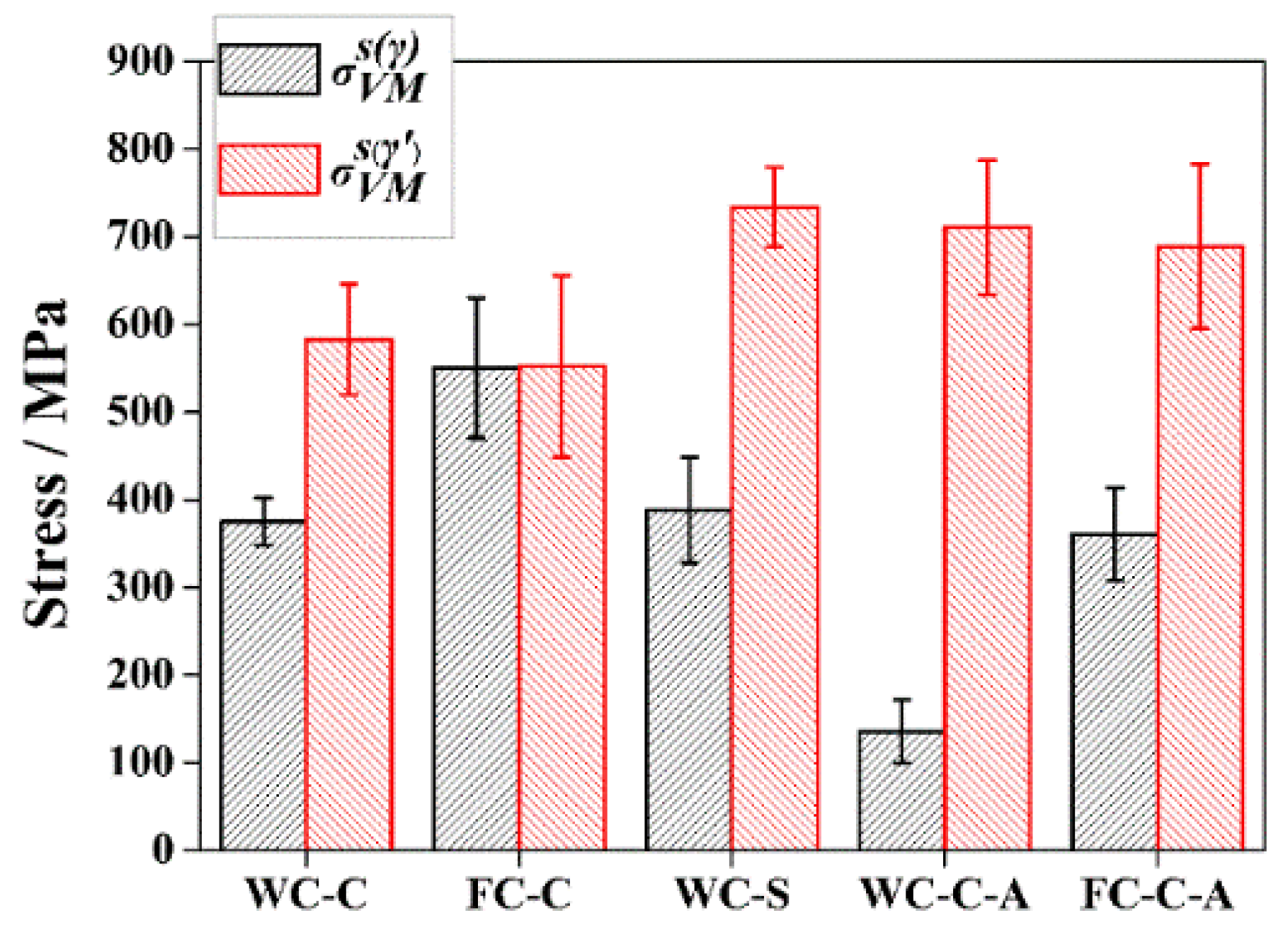
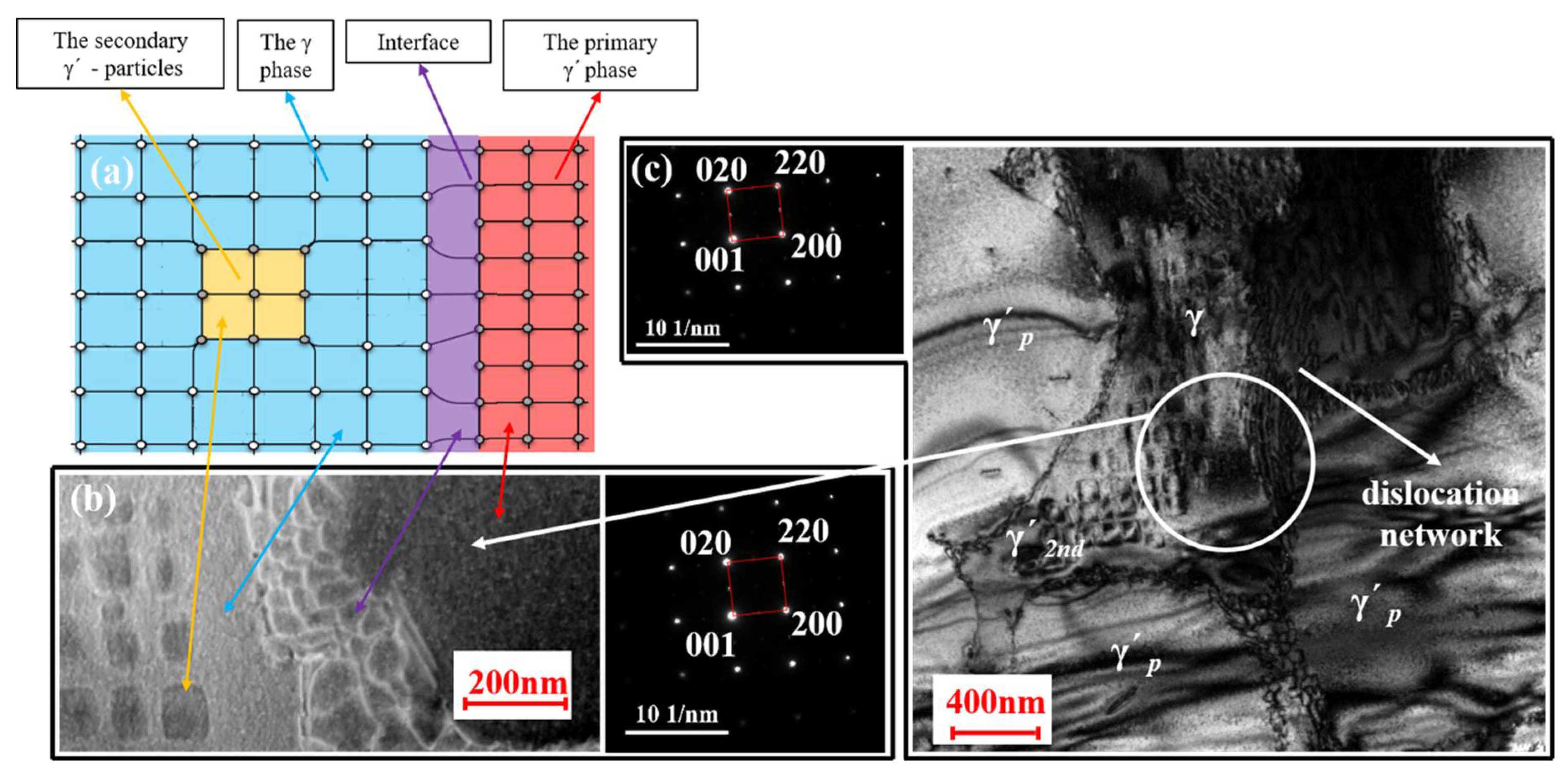
| Sample No. | Cross-Section Shape | Cooling Conditions |
|---|---|---|
| ① WC-C | Circle | Water Cooling after solid solution |
| ② FC-C | Circle | Furnace cooling to 300 °C after solid solution |
| ③ WC-S | Square | Water Cooling after solid solution |
| ④ WC-C-A | Circle | Aging then furnace cooling to 300 °C based on Sample ① |
| ⑤ FC-C-A | Circle | Aging then furnace cooling to 300 °C based on Sample ② |
| Samples | WC-C | FC-C | WC-S | WC-C-A | FC-C-A | |||||
|---|---|---|---|---|---|---|---|---|---|---|
| γ | γ′ | γ | γ′ | γ | γ′ | γ | γ′ | γ | γ′ | |
| a/[010] | 3.58 | 3.574 | 3.586 | 3.574 | 3.585 | 3.575 | 3.584 | 3.575 | 3.582 | 3.577 |
| b/[100] | 3.578 | 3.574 | 3.586 | 3.574 | 3.586 | 3.575 | 3.584 | 3.574 | 3.583 | 3.572 |
| c/[001] | 3.581 | 3.578 | 3.590 | 3.578 | 3.585 | 3.579 | 3.585 | 3.581 | 3.590 | 3.580 |
© 2018 by the authors. Licensee MDPI, Basel, Switzerland. This article is an open access article distributed under the terms and conditions of the Creative Commons Attribution (CC BY) license (http://creativecommons.org/licenses/by/4.0/).
Share and Cite
Duan, H.; Qin, L.; Pei, Y.; Li, S.; Zhao, L.-D.; Ji, V.; Gong, S. Investigations into the Surface Strain/Stress State in a Single-Crystal Superalloy via XRD Characterization. Metals 2018, 8, 376. https://doi.org/10.3390/met8060376
Duan H, Qin L, Pei Y, Li S, Zhao L-D, Ji V, Gong S. Investigations into the Surface Strain/Stress State in a Single-Crystal Superalloy via XRD Characterization. Metals. 2018; 8(6):376. https://doi.org/10.3390/met8060376
Chicago/Turabian StyleDuan, Haodong, Lu Qin, Yanling Pei, Shusuo Li, Li-Dong Zhao, Vincent Ji, and Shengkai Gong. 2018. "Investigations into the Surface Strain/Stress State in a Single-Crystal Superalloy via XRD Characterization" Metals 8, no. 6: 376. https://doi.org/10.3390/met8060376






